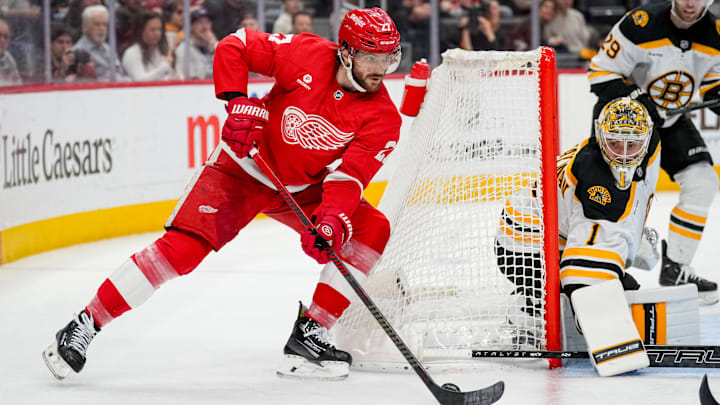Having debuted with the Red Wings in 2018, it is hard to believe that 2024-2025 was only Michael Rasmussen’s age-25 season. It already feels like he has lived a full career in Detroit, transitioning from a draft bust early in his career to now being a fan favorite.
Fans and media alike were not asking a lot out of Rasmussen entering this season. The days of hoping the former ninth overall pick would approach 20-30 goals or 70 points are long gone. Instead, Rasmussen has carved out a role as a more physical presence for the Red Wings and the expectation was he would continue that into 24-25.
The only reason to desire more out of Ras was because he signed a contract extension with Detroit during the 2023-2024 season, keeping him with the team through the 2027-2028 season at a $3.2 million cap hit. It is not a large financial commitment, but there was hope that he could reach another level since the Wings were sticking with him long-term.
Rasmussen's offensive struggles continued this season.
Rasmussen did not ultimately reach a new level in 24-25 and his season went essentially as expected, albeit with a few highs and lows.
Coming off a 13-goal and 20-assist campaign in 23-24, Ras had only 11 goals and 10 assists this year. He also was a minus 12, the second-worst mark of his career and his first season finishing as a negative player since 2021-2022.
Scoring seemingly will never be a focal point of Rasmussen’s game, but hopefully he can find a way to produce a little more as he enters his physical prime because 21 points is just not enough even for a player with his contract.
More offensive production will likely lead to more ice time as well, seeing that Ras’ 13:25 average ice time was the lowest since his rookie year.
On a "soft" Red Wings team, Rasmussen continued to be one of the few to bring the physical punch.
On the bright side, Rasmussen continued to bring the physicality for a Red Wings team that severely lacked it throughout the season. He was third on the team in hits with 141, one shy of his career-high of 142 in 21-22. He was also eighth on the team in blocks with 59.
Due to the Wings’ injuries and lack of depth, Rasmussen played significant time on the second power play and penalty kill units. Although he was prone to the occasional lapses or missed assignments, he played admirably in these roles especially as a net-front presence on the power play.
It is also worth noting that, of the Red Wings who took the majority of face-offs, Rasmussen’s winning percentage was fourth on the team at 46.4%.
Pardon the hockey cliches, but it is impossible to talk about Rasmussen without mentioning the intangibles he brings. It always seemed that Ras would have a huge hit, a key block, or a game-clinching empty-netter (see: October 24th vs. New Jersey) that would give the Wings momentum and get the fans going. In a season that saw Detroit look lethargic all too often, Rasmussen was one of the few players you could count on to bring the energy and physicality.
Michael Rasmussen’s 2024-2025 season grade: C
Ultimately, it was an average season for Rasmussen and that is why he received a C. He continued to be strong in bringing physicality and energy to the team, while continuing to fall short in offensive production.
Looking ahead to next year as Rasmussen begins his physical prime, hopefully, he has a little more offense in the tank and he can evolve into more than just an energy guy. However, it will be his seventh-full season in Detroit, so it is more likely he maintains this same level of production.
